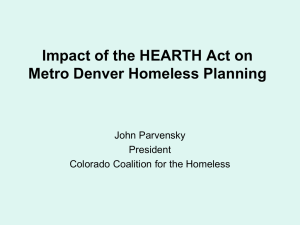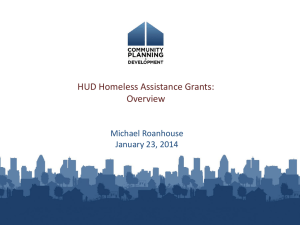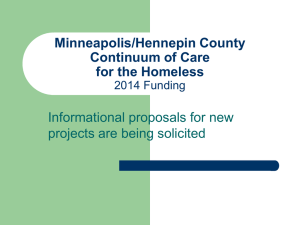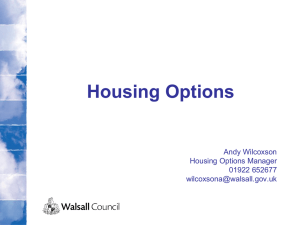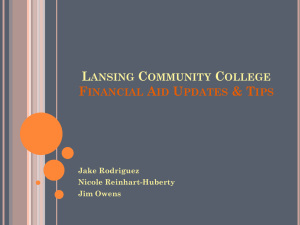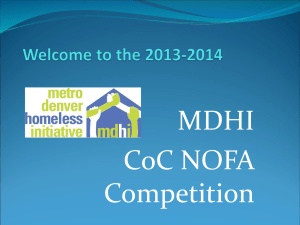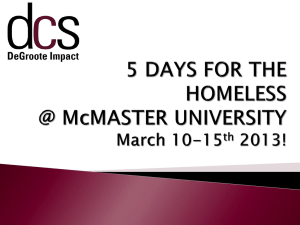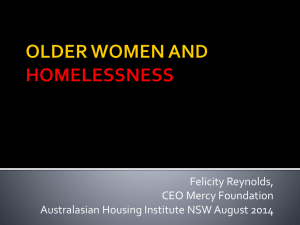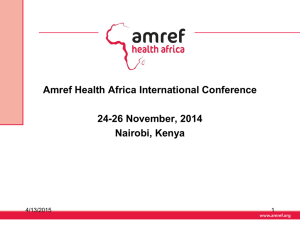CoC General Orientation - Strategies to End Homelessness
advertisement
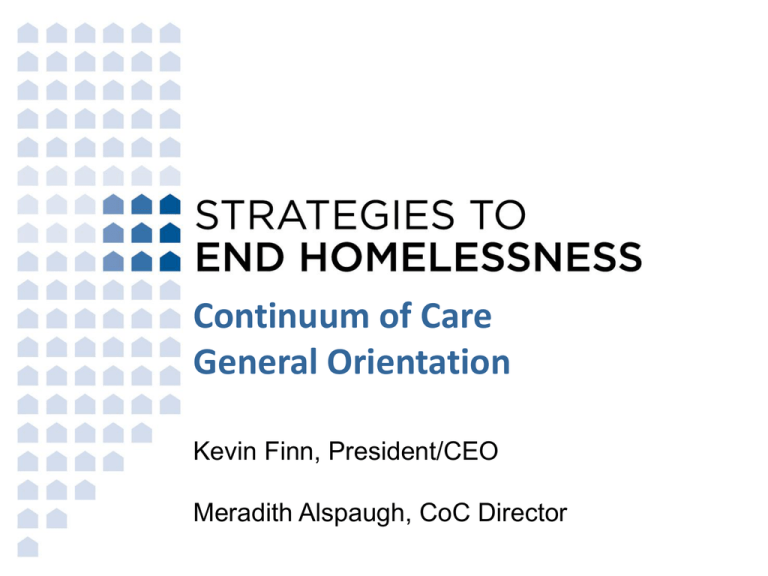
Continuum of Care General Orientation Kevin Finn, President/CEO Meradith Alspaugh, CoC Director HEARTH Act The Hearth Act reauthorized The McKinney Vento Homelessness Assistance Act with the following changes: • Consolidate HUD’s competitive grant programs • Codify the Continuum of Care planning process • Change HUD’s definition of homelessness • Increase in prevention resources • Increased emphasis on performance & outcomes CoC Program—Purpose Promote Community wide commitment to end homelessness Quickly re-house homeless individuals and families Improve access to and use of mainstream programs Optimize self-sufficiency What is the Continuum of Care • The CoC is the group responsible for carrying out the duties defined in the Continuum of Care Program interim rule. • The CoC is composed of representatives of relevant organizations within the geographic area served by the Continuum. • Once established, the CoC is required to appoint a CoC board and to designate an HMIS lead agency and a collaborative applicant to assist with its responsibilities. The Continuum of Care CoC Board (The Homeless Clearinghouse) •The group appointed to act on behalf of the CoC which must be representative of the relevant organizations and of projects serving homeless subpopulations and include at least one homeless or formerly homeless individual. City of Cincinnati Executive Directors ESG Recipient 3 CoC Hamilton County ESG Recipient 1 non-CoC ESG Recipient: Shelter Diversion People who Experienced Homelessness (2) TBD Homeless Clearinghouse ESG Recipient: Shelter Drop Inn Center Homeless Advocate Homeless Coalition (CoC Board) CoC Working Group Reps* (6) HMIS Lead & Collaborative Applicant Strategies to End Homelessness Health Care for the Homeless CHN Education Liaison Veterans Services VA Project Connect * The CoC Working Groups: the Family Housing Partnership, Homeless Outreach Group, HMIS Advisory Committee, Permanent Supportive Housing Group, Rapid Re-Housing Group, & Transitional Housing Group Collaborative Applicant (Strategies to End Homelessness) • The Collaborative Applicant is an eligible applicant designated by the CoC to apply for HUD funds on the CoC’s behalf. • Other responsibilities as designated by the CoC Governance Charter HMIS Lead Agency (Strategies to End Homelessness) • The HMIS Lead agency is the eligible CoC applicant designated by the CoC to oversee the day to day operations of the HMIS • STEH contracts with the Partnership Center to carry out the HMIS Lead Agency responsibilities Responsibilities of the CoC Operating the CoC System Operations Responsibilities •Develop written standards, in consultation with ESG recipients, to prioritize individuals and families eligible to receive the assistance, and the amount and type of assistance they should receive. •Establish performance expectations and monitor individual project and system performance •Coordinated Assessment Centralized Intake or Coordinated Assessment System Each Continuum of Care is required to develop and implement a centralized or coordinated assessment system for its geographic area. Such a system must be designed locally in response to local needs and conditions. Participation is required of all CoC and ESG recipients and sub-recipients. Centralized, Coordinated Intake & Assessment Emergency Shelter Rapid ReHousing Shelter Diversion Street Outreach Transitional Housing SYSTEMATIC CONNECTION TO THE SERVICE THAT BEST MEETS THE NEEDS OF THE CLIENT Permanent Supportive Housing Responsibilities of the CoC Operating the CoC Governance Responsibilities •Establishing the structure and governance charter of the CoC •Establishing workgroups Responsibilities of the CoC Designate and operate the HMIS for the CoC Cincinnati/Hamilton County utilizes VESTA™ as our HMIS Responsibilities of the CoC CoC Planning •Develop a housing and service system to meet the needs identified within the jurisdiction •Participate in the Consolidated planning process for the jurisdiction •Design and follow a collaborative process to select projects to apply for CoC funds Supporting movement toward stable, permanent housing • Prevention/Shelter Diversion • Street Outreach • Emergency Shelter • Transitional Housing •Rapid Re-housing • Permanent Supportive Housing Where do you fit within the system? Eligible Project Applicants •Non Profits, States, local government, and instrumentalities of local government •MUST be designated by the CoC to apply for funds Exclusion: for profits are not permitted to apply for grants or be sub-recipients of grants CoC Program Grant Uses and Requirements 1. Permanent Housing (2 types: PSH & RRH) 2. Transitional Housing 3. Supportive Services Only 4. Homeless Management Information System 5. Homelessness Prevention* * For HUD-designated High Performing Communities Only. Eligible Components: Permanent Housing 1. Permanent Housing : Community based housing, the purpose of which is to provide housing without a designated length of stay. It includes: a. Permanent Supportive Housing (PSH) I. Programs formerly known as S+C and some SHP Permanent Housing Programs II. Provides long-term housing assistance to homeless individuals and families in which one adult or child has a disability III. PSH Programs PRIORITIZE Chronically homeless individuals and families Eligible Components: Permanent Housing b. Rapid Re-Housing (RRH) I. Programs formerly known as scattered-site Transitional Housing and some “short-term” SHP Permanent Housing Programs II. Designed to help homeless individuals and families move as quickly as possible into permanent housing and achieve stability in that housing. III. Provides short and/or medium-term assistance (up to 24 months) IV. The program participants KEEP the housing/unit when assistance ends. Eligible Components: Transitional Housing 2. Transitional Housing: i. Programs designed to facilitate the movement of homeless individuals and families to Permanent Housing ii. Program participants must MOVE to other housing when assistance ends. iii. Program participants must have a lease or occupancy agreement with a term of at least one month that cannot be extended beyond 24 months Eligible Components: Supportive Services Only (SSO) 3. Supportive Service Only I. Provide supportive services to unsheltered and sheltered homeless individuals and families (for whom the recipient/sub recipient is not providing housing or housing assistance). II. Includes Street Outreach and Centralized/coordinated assessment intake Eligible Components: HMIS 4. Homeless Management Information System (HMIS) I. Provides assistance to CoCs to administer and operate the HMIS II. May only be awarded to the HMIS lead designated by the CoC Eligible Costs under the CoC Program Acquisition Use: Grant funds may be used to pay up to 100% of the cost of acquisition of real property selected by the recipient for use in the provision of housing or supportive services for homeless persons. Rehabilitation Use: Grant funds may be used to pay up to 100% of the cost of rehabilitation of structures to provide housing or supportive services to homeless persons. Eligible costs: installing cost-effective energy measures, and brining an existing structure to state and local government health and safety standards. Ineligible costs: Grant funds may not be used for rehabilitation of leased property. New Construction Use: Grant funds may be used to: • Pay up to 100 % of the cost of new construction, including the building of a new structure or building an addition to an existing structure and the cost of land associated with that construction, for use as housing. • If grant funds are used for new construction, the applicant must demonstrate that the costs of new construction are substantially less than the costs of rehabilitation or that there is a lack of available appropriate units that could be rehabilitated at a cost less than new construction. Ineligible costs: funds may not be used for construction on leased property. Leasing Use: Grant funds may be used to lease structures or individual units to provide housing or services to homeless persons Eligible Costs: • Funds may be used to pay up to 100% of rent charged by property owner. • If utilities are included in rent, these utilities may be paid from leasing funds. • Security deposits, not to exceed 2 months of actual rent may be paid on participant’s behalf • An advance payment of last month’s rent may be provided to landlord in addition to the deposit. Leasing Cont’d Requirements: Leasing projects are required to have occupancy agreements and subleases (Recipient holds lease—NOT program participant) Occupancy charges and rent from participants must be calculated as provided in 578.77. Occupancy charges and rent collected from program participants are considered program income. Rents paid MUST be reasonable Housing must meet Housing Quality Standards (HQS) within 30 days of initial inspection and annually as unit receives assistance. Projects receiving leasing assistance may not receive rental assistance, acquisition, rehab or construction funds Rental Assistance Use: Grant funds may be used to provide short, medium, and long-term rental assistance. Eligible Costs: • Rent • Security deposits, not to exceed 2 months of actual rent may be paid on participant’s behalf • An advance payment of last month’s rent may be provided to landlord in addition to the deposit. Rental Assistance Cont’d Requirements: Rental assistance must be administered in accordance with policies and procedures established by the CoC. PSH rental assistance must be administered by CMHA Rents paid MUST be reasonable Housing must meet Housing Quality Standards (HQS) within 30 days of initial inspection and annually as unit receives assistance. Supportive Services Use: grant funds may be used to pay the eligible costs of supportive services that address the special needs of the program participants. Requirements: Supportive services must be necessary to assist program participants obtain and maintain housing. Recipients shall conduct an annual assessment of the service needs of the program participants and should adjust services accordingly. Supportive Services Cont’d Duration: For TH, supportive services must be made available to residents throughout the duration of their participation. PSH projects must provide supportive services for the residents to enable them to live as independently as is practicable throughout the duration of their residence in the project. Services may be provided to former residents of TH and current residents of permanent housing who were homeless in the prior 6 months, for no more than 6 months after leaving TH or homelessness, to assist their adjustment to independent living. Rapid re-housing projects must require the program participant to meet with a case manager not less than once per month to assist the program participant in maintaining long-term housing stability. Supportive Services Cont’d Eligible Costs: Annual Assessment of Service Needs Assistance with moving costs Case management Child care Education services Employment assistance and job training Food Housing search and counseling services Legal services Life skills training Mental health services Outpatient health services Outreach services Substance abuse treatment services Transportation Utility deposits Direct provision of services Any other cost not listed here is considered ineligible under this section! Operating Costs Use: Grant funds may be used to pay the day to day operation of TH and PH housing in a single structure or individual units. Eligible Costs: Maintenance Property taxes and Insurance Scheduled payments to reserve for replacement of major systems Security Electricity, gas, and water Furniture equipment Ineligible Costs: funds may not be used for rental assistance and operating in the same project. Funds may not be used for operating costs of shelter or services only facilities Funds may not be used for maintenance and repair if those costs are included in the lease. HMIS Use: Grant funds may be used to pay the costs of contributing data to the HMIS designated by the Continuum of Care Eligible Costs: Paying salaries for operating HMIS, including: Completing data entry; Monitoring and reviewing data quality; Completing data analysis; Reporting to the HMIS Lead; Training staff on using the HMIS; and Implementing and complying with HMIS requirements; Administration Use: The recipient or sub recipient may use up to 7%* percent of the grant award for the payment of project administrative costs related to the planning and execution of the project. Ineligible: This does not include staff and overhead costs directly related to carrying out eligible activities because those costs are eligible as part of those activities. *per most recent Nofa Admin Cont’d Eligible Costs: General management, oversight, and coordination. Training on Continuum of Care requirements Environmental Review Program and Grant Administration Requirements Program and Application Requirements Renewal Programs Grant Funds Expended (local requirement) must expend certain % in order to renew (amount to be set by Clearinghouse) New Programs Housing Focus: at least 80% of funds must be in rental assistance, leasing, operating, new construction, and/or, rehabilitation. Eligible Programs: RRH for Families or PSH for CH individuals or families Program and Application Requirements New AND Renewals Match – All funds, except leasing, must be matched with no less than 25% of funds or inkind contributions from other sources on a grantby-grant basis. Leverage- Leveraging is source or provider funding (cash and in-kind) which are not parts of the operating or services budget of the requested grant funds (150% required) MATCH AND LEVERAGE ARE SEPARATE AND DISTINCT. THE CASH AND IN-KIND AMOUNTS LISTED AS A SOURCE OF LEVERAGE ARE ABOVE AND BEYOND THE CASH AND IN-KIND AMOUNTS LISTED AS MATCH FOR THE PROPOSED PROJECT. Who can be served by CoCfunded Programs? A look at the definitions of homelessness… Definition of Homelessness HUD published the Final Rule revising the definition of “homeless” on December 5, 2011 The new definition is applicable to: •Projects funded under the Emergency Solutions Grant •New and Renewal Projects funded by CoC funds Category 1-Literally Homeless • An individual or family who lacks a fixed, regular, and adequate nighttime residence; • An individual or family with a primary nighttime residence that is a public or private place not designed for or ordinarily used as a regular sleeping accommodation for human beings; • An individual or family living in a supervised publicly or privately operated shelter designated to provide temporary living arrangements; Category 2—At imminent risk of homelessness Individuals and families who will imminently lose their primary nighttime residence within 14 days AND – Have no subsequent residence identified AND – Lack the resources or support networks needed to obtain other permanent housing. Category 3—Homeless under other federal statute Unaccompanied youth under 25 or families with children and youth who do not otherwise qualify as homeless, but who: – Meet homeless definition under other federal statute: AND – Have not had a lease, ownership interest, or occupancy agreement in permanent housing at any time during the last 60 days; AND – Have experience two or more moves during the last 60 days; AND – Can be expected to continue in such status for an extended period of time because of: chronic disabilities, OR chronic physical health or mental health conditions, OR substance addiction, OR histories of domestic violence or childhood abuse (including neglect) OR presence of a child or youth with a disability, OR two or more barriers to employment Category 4-Fleeing Domestic Violence Individuals and families who are fleeing, or are attempting to flee, domestic violence, dating violence, sexual assault, stalking, or other dangerous or lifethreatening conditions related to violence, who: Have no identified subsequent residence; AND Lack the resources and support networks needed to obtain other permanent housing. Important notes on the Homeless Definition • CoCs must obtain HUD approval to serve Category 3 (We do not have this approval) • PSH programs can only serve persons who were homeless on the street or in a shelter (Not category 2) • CoC prioritization and eligibility policies and procedures may further limit who can be served in CoC programs (i.e. RRH and TH program policies require that a person come from the street or shelter prior to entry into RRH or TH program and PSH prioritizes CH) Chronic Homelessness An unaccompanied homeless individual with a disabling condition or an adult member of a homeless family who has a disabling condition who has been: • continuously homeless for 1 year or more, OR •has had at least four episodes of homelessness in the past 3 years. Prioritized vs dedicated chronic homeless beds Overview of “At-Risk of Homelessness” At-Risk of Homelessness definition has 3 categories applicable to: 1. Individuals and families 2. Unaccompanied children and youth 3. Families with children and youth “At-Risk” Means NOT eligible for housing and services for people who are already homeless! At-Risk of Homelessness Category 1 Has income below 30% of Area Median Income; AND Do not have sufficient resources or support networks immediately available to prevent literal homelessness; AND Meet at least one of the following conditions: 1. Moved two or more times due to economic reasons in 60 days prior to application for assistance 2. Is living in the home of another because of economic hardship 3. Losing housing within 21 days after application date 4. Lives in a hotel or motel; 5. Lives in severely overcrowded housing; 6. Is exiting an institution; or 7. Otherwise lives in housing that has characteristics associated with instability and an increased risk of homelessness. At-Risk of Homelessness Categories 2 & 3 Category 2 Unaccompanied children/youth who qualify under other federal statutes Category 3 Children/youth who qualify under the Education for Children and Youth Program and the parents or guardians of that child/youth if living with him/her. The local Shelter Diversion Program will serve individuals and families who qualify under category 1 How does a program get into our CoC’s annual application to HUD? 1. Pre-measured Elements 2. Community Ranking Pre-Measured Elements: •Housing Outcomes •Income Outcomes •Employment Outcomes •Returns to Homelessness •Families •Chronic Homelessness OUTCOMES MATTER!!! Higher performance = higher pre-score! Community Ranking Large Group Scoring • All agencies present about programs • CoC members rank programs in order of highest priority for our community Pre-Score + Rank = final prioritization list Permanent Housing Bonus Funding • Not Applicable in 2014 National Scoring of CoC Application by HUD (OH-500) Consolidated CoC Application* • Encompasses everything the CoC does and produces year-round Project Application • Written by Agencies requesting new or renewal grants • Written by STEH • Must pass a capacity review – conducted by the HUD Field Office • Scored nationally by HUD in Washington • Pass/Fail in Washington *Not applicable in 2014 2014 Timeline June 27th- Large Group Scoring Training* July 7th - Large Group Scoring Training* July 11th- Large Group Scoring Training* July 18th- Large Group Scoring TBD (late Summer) Project Applications Due TBD (late Summer) CoC Application Due *Required to attend only one. See website for more info! Additional Resources www.strategiestoendhomelessness.org • Budget, Match, and Leverage Templates • Large Group Scoring guidance • Registration for all trainings and Large Group Scoring event • Other info as it becomes available! Questions? Meradith Alspaugh 513-263-2783 malspaugh@end-homlessness.org Kevin Finn, MSW, LISW-S 513-263-2788 kfinn@end-homelessness.org
